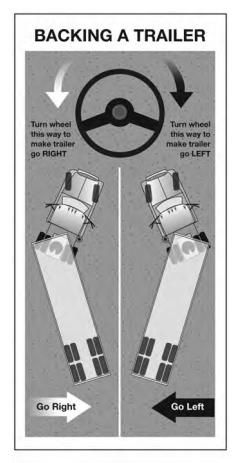Review Questions - Click On The Picture To Begin...

- If you back and turn toward the driver's side, you can watch the rear of your vehicle by looking out the side window
- Backing towards the drivers side offers better visibility than backing towards the right side
- Less accidents occur while backing towards the drivers side instead of the passenger side
- By backing towards the drivers side, you should be able to keep your window closed during inclement weather
Quote From The CDL Manual:
Back to the driver's side so you can see better. Backing toward the right side is very dangerous because you cannot see as well. If you back and turn toward the driver's side, you can watch the rear of your vehicle by looking out the side window. Use driver-side backing-even if it means going around the block to put your vehicle in this position. The added safety is worth it.
TruckingTruth's Advice:
Backing towards the passenger side is often referred to as "blind side backing." It is very dangerous due to low visibility and should be avoided whenever possible, especially in a combination vehicle.
- Keep moving
- Stop
- Slow down
- Pull forward
Quote From The CDL Manual:
Use a helper when you can. There are blind spots you cannot see. The helper should stand near the back of your vehicle where you can see them. Before you begin backing, work out a set of hand signals that you both understand. Agree on a signal for "stop."
- When backing a trailer, drivers can pull forward to re-position the vehicle
- This is the term used to describe how to climb into a truck
- A pull up refers to a specialized shifting technique
- Driving up a steep grade is usually called a pull up
Quote From The CDL Manual:
When backing a trailer, make pull-ups to reposition your vehicle as needed.
- Partly engage the clutch before you take your right foot off the brake
- On a tractor-trailer equipped with a trailer brake hand valve, the hand valve can be applied to keep from rolling back
- All of these are correct
- Engage the parking brake and only release it when you have applied enough engine power to keep from rolling back
Quote From The CDL Manual:
Do not roll back when you start. You may hit someone behind you. Partly engage the clutch before you take your right foot off the brake. Put on the parking brake whenever necessary to keep from rolling back. Release the parking brake only when you have applied enough engine power to keep from rolling back. On a tractor-trailer equipped with a trailer brake hand valve, the hand valve can be applied to keep from rolling back.
- If you lose sight of your helper, keep moving back slowly and cautiously until the helper becomes visible again
- If you lose sight of your helper, stop and get out to look
- Have the helper stand near the rear of the vehicle where you can see the helper
- Before you begin backing, work out a set of hand signals you both understand
Quote From The CDL Manual:
Use a helper when you can. There are blind spots you cannot see. The helper should stand near the back of your vehicle where you can see them. Before you begin backing, work out a set of hand signals that you both understand. The most important signal to agree on is a signal for "stop". If you lose sight of your helper, you should stop immediately and get out of the truck to look.
TruckingTruth's Advice:
During backing, a helper should only be used as an additional tool to backing safely. Never put 100% trust into the helper and when in doubt, always stop and get out to look.
- Keep one hand on the top of the steering wheel and another hand on the bottom of the steering wheel
- Use one hand with a firm grip on the top of the steering wheel
- Hold the steering wheel firmly with both hands on opposite sides of the wheel
- Hold the steering wheel loosely in the 10 o'clock and 2 o'clock positions
Quote From The CDL Manual:
Hold the steering wheel firmly with both hands. Your hands should be on opposite sides of the wheel. If you hit a curb or a pothole (chuckhole), the wheel could pull away from your hands unless you have a firm hold.








 TT On Facebook
TT On Facebook